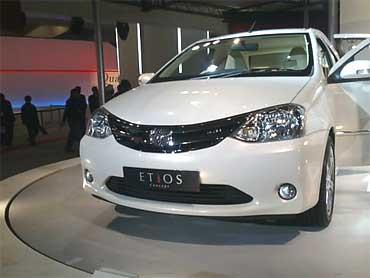
In 1989, Toyota launched the Lexus at the top end of the market.
In 2005, it came out with the IMV platform on which were launched the Innova multi-purpose vehicle, the Fortuner sports utility vehicle and the Hilux pickup truck.
Both proved to be game changers for the world's largest car maker.
The Lexus gave it an entry into the luxury market, while the IMV vehicles helped it grow in the emerging markets of Asia, Africa and South America.
No less important will be the launch of the Etios in India some time towards the end of the year, says Toyota Kirloskar Motor Pvt Ltd (Toyota's 89:11 joint venture with the Kirolskars) deputy managing director Sandeep Singh.
The reasons are elementary: It will help Toyota gain critical mass in a large market (estimated size: 3 million in 2010-11), and the platform could yield more cars for other emerging markets in the days to come.
. . .
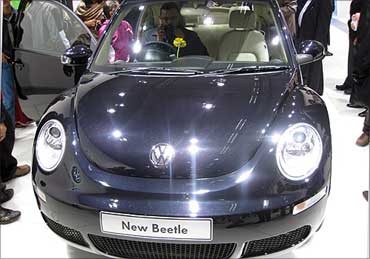
Numbers do matter. Volkswagen wants to dislodge Toyota as the world's largest car maker by 2018. The gap between the two is not huge.
In 2009, Volkswagen sold 6.29 million cars against Toyota's 7.81 million cars. India could well decide who wins finally.
Volkswagen has launched the Polo hatchback and sedan (Vento), and invested Rs 3,200 crore (Rs 32 billion) in a new factory at Chakan near Pune that can roll out 110,000 cars in a year.
The Etios could be Toyota's answer. So far, Toyota has been present in just 15 per cent of the Indian market with the Altis, Camry, Innova, Fortuner, Prius, Prado and Land Cruiser.
The Etios will expand it to around 50 per cent. It will compete against the likes of Maruti Suzuki Swift, Hyundai i20, Nissan Micra, Volkswagen Polo and Ford Figo.
Toyota has spent over Rs 3,000 crore (Rs 30 billion) in a production facility for the car near Bengaluru.
Its capacity will be 100,000 cars per annum, which can be doubled in the future. It wants to sell 70,000 Etios, hatchback as well as sedan, in 2011, which could double its sales in the country.
. . .

By 2015, Toyota wants to sell 300,000 in India. Rivals say Toyota is a little late to hit the market. Still, much is at stake. Nothing can be left to chance.
Toyota spent the whole of 2007 researching the Indian market. Teams met different customers groups: Young people, old, single, married etc. Dealers were taken on board to get their feedback.
In early 2008, Toyota finally said it would go ahead with the car. Since then, Narita Ke, the chief engineer of the Etios, has made innumerable trips to India, and lived with families here to understand their habits and needs.
He observed, for instance, that all Indians are in a hurry to take off as soon as the traffic signal turns green; they therefore need that additional pick up.
Similarly, a car has to be easy to park. Indians often accommodate three passengers on the back seat; so it is essential to give good comfort towards the rear of the car.
. . .

The Etios, which has been developed in Japan, will 'give a very good driving experience, very good space, high ground clearance and best-in-class fuel efficiency,' says Singh.
Fuel efficiency and the cost of ownership, experts will tell you, make or break a car in India.
This is why Maruti Suzuki has done so well in the country.
Singh says that the life of all Toyota parts is long, which reduces the need for replacements.
"We have proved that Toyota cars require very low maintenance. That's why their resale value is the highest. For a five-year old Innova, the erosion in value is just 30 to 40 per cent.
A 10-year old Qualis fetches 50 per cent of the original value; a five-year old Qualis can get 70 to 80 per cent."
. . .
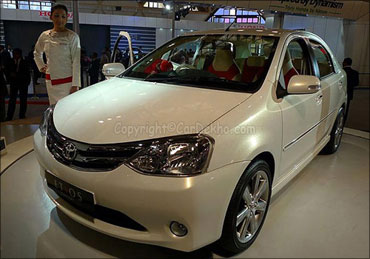
The right price
Much will also depend on the price tag Toyota puts on the Etios.
The car maker has so far kept the rice under wraps.
Singh says the hatchback will be targeted at young executives with a take home salary of Rs 30,000 to Rs 50,000 per month, and the sedan at those with a salary of Rs 75,000 per month and above.
Experts say that Toyota, because of its brand equity, can command a premium, though it can't be very high.
"Toyota does command a premium of 5 to 7 per cent over others," says Synovate India associate director & head of Motoresearch Sumit Arora.
"But the example of the Honda Jazz shows that consumers are not willing to pay a hefty premium for a hatchback."
But this is where Toyota could spring a surprise. Singh says that Toyota has done strategic pricing of its cars in the past and will do that with the Etios as well.
"You don't look at profits in the short run. I don't think we have done that with any product, even when we launched the Qualis.
You look at profit from a product over a period of time. It includes not just your vehicle but also spare parts, merchandise and accessories.
"Frankly speaking, most companies take much longer than three or four years to recover the investments."
. . .
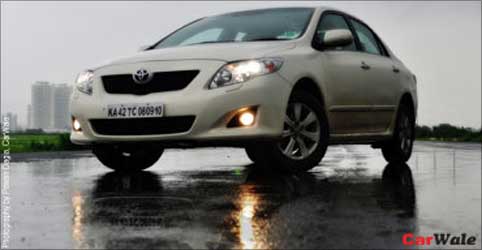
Singh discloses that Toyota Kirloskar broke even a couple of years ago, though it went into business way back in 1997.
To keep the costs low, the company will source 70 per cent of the components of the Etios locally.
Six key vendors have set up shop within its plant at Bengaluru.
The transmission and engine will come from Japan to begin with.
By 2012, the transmission will be made locally, and by 2013, so will the engine. That is when localisation will shoot up to 95 per cent.
But even Toyota knows that there are limits to strategic pricing.
That's what deters it from launching a small car in India, though it does have in its portfolio the Yaris and the Daihatsu range.
. . .
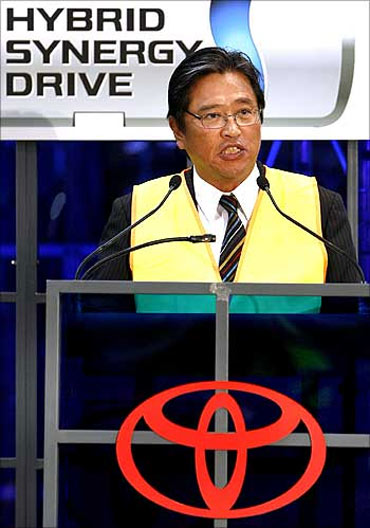
"Toyota is not looking to develop a low-cost car for India at this moment because it believes that, given the standards it wants to maintain, it is very difficult to develop a car at those prices," says Singh.
Toyota knows this means that it will have to play second fiddle to rivals like Maruti Suzuki for several years. But it is willing to wait.
Sometime last year, Singh and his team carried out a brand recall survey.
It showed that in the top ten cities, Toyota came third after Maruti Suzuki and Honda in cars. In multi-purpose vehicles, it was on top. But in semi-urban markets, it fell to the fifth or sixth slot.
Many people, in those markets, weren't even aware that Toyota made cars; they thought it only made multi-purpose vehicles.
So, the company decided to take the Etios, along with the entire Toyota range, to ten cities that account for 70 per cent of the car sales in the country under the Q (quality) World programme.
. . .

The list was then expanded to 20 and finally 24.
The gains? Singh says that a recent survey has shown that Toyota's brand recall in the top 10 cities has jumped to number two, at par with Honda; two, feedback was obtained from 1,200 customers on the car, which has led to some last-minute tweaks; and three, 54,000 of the 150,000 people who saw the car have registered their interest in it. Some of them could end up buying the car.
Harping on quality
At the same time, Toyota has launched a campaign called Q Promise along with its agency, Dentsu.
"We are working on an emotional connection with the customer. We are not talking about products; we are talking about what goes into the high-quality product we give you. We have talked about manufacturing and safety, and will talk about dealers, vendors etc," says Singh.
In another departure from the convention, Toyota may rope in a brand ambassador for the Etios.
Singh rules out the possibility of a cricketer or a film star because 'they have been used by all'.
. . .
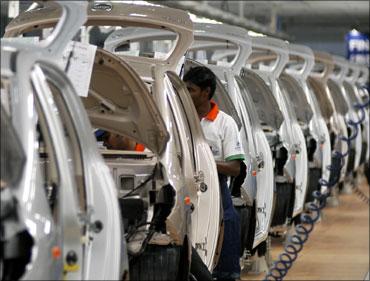
The market is rife with the talk that it could be music maestro AR Rahman. Singh admits that Rahman does not fall in the category of overexposed film stars.
Cleverly, Toyota has launched two high-end vehicles, the Prius hybrid and Fortuner, in the last one year.
They might not have given huge volumes, but have boosted the car maker's brand equity in India.
The most vital link in the Etios gameplan is the Toyota dealer. The company has raised the number of dealers from 40 to 60 and the number of sale and service points from 82 to 150 in the last two years.
The numbers might look small but, Singh claims, cover almost 85 per cent of the market. Apart from land, a Toyota dealership can cost as much as Rs 30 crore (Rs 300 million).
To keep the dealers happy, Toyota gives them higher profit margins of 4 per cent on cars (industry norm is 3 to 3.5 per cent) and 18 to 20 per cent on spares (industry: 15 per cent).
Eighty per cent of the owners bring their cars to a Toyota authorised station for service in the warranty period (industry: 50 to 60 per cent), which falls to 70 per cent after the warranty (industry: 30 to 40 per cent). This keeps the cash registers ringing.
Also, conversion of footfalls in Toyota dealerships is 32 per cent, way above the industry average of 20 per cent.
. . .

All prospective customers are required to take a test drive, though 70 to 80 per cent actually do that -- this way customers can feel the difference in the drive quality.
Still, claims Singh, this is better than the industry practice of 30-40 per cent.
All cars meant for test drives are replaced within two years. "We train everybody in the dealership, even the doorman and the attendant who serves tea," says Singh.
Still, Singh says that breakeven for a Toyota dealer can take up to seven years, higher than the industry norm of four to five years.
The missing link here, according to Singh, is the appreciation in the value of the asset. Most of the initial Toyota dealers were encouraged to set up large dealerships in the fringes of the city, away from downtown, to keep the real estate cost down.
Many of them, Singh says, have now come inside the fast-expanding city.
"So far, only one dealer has left us, and 99 per cent of our dealers have expanded," says Singh. The dealers are important for another reason: Till date, Toyota has sold 460,000 vehicles in India to around 320,000 customers. This base will be tapped for the Etios.
"We hope to get 50 per cent of the Etios volumes from our existing customers," says Singh.
The customer, says Singh, is central in Toyota's worldview. The company therefore no longer talks about market share targets. It clearly is a long-term player.